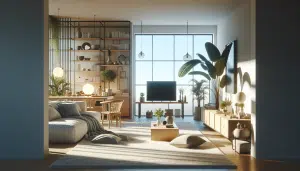Tiny Homes Lifestyle Trends You’ll Want to Explore
Lily Carter September 27, 2025
Discover how the tiny homes movement is changing lifestyles and inspiring creative living spaces. This guide reveals how downsizing, smart design, and minimalism can unlock freedom, savings, and new forms of entertainment for those seeking flexible and sustainable ways to live.
Embracing the Tiny Homes Revolution
The tiny homes movement captivates a growing number of people eager to rethink traditional living. Minimalism, downsizing, and efficient design are reshaping how individuals live, making the idea of tiny home ownership more appealing than ever. Across urban and rural areas, interest in this lifestyle surges thanks to its unique blend of sustainability and practicality. For many, the decision to embrace a smaller space is motivated by the desire for more freedom—financially and emotionally. Unburdened by oversized mortgages or excess belongings, tiny home dwellers report lower stress levels and greater flexibility in their daily routines, suggesting why this trend continues to thrive. The shift isn’t simply about space, but about crafting an intentional life.
Adopting a minimalist lifestyle is central to the tiny home movement. Simplifying possessions encourages mindful consumption and focuses on experiences instead of things. Trends in lifestyle and entertainment now showcase how people adapt shared areas for hobbies, social gatherings, or wellness activities within limited square footage. The mental clarity that follows decluttering is well-documented, and many discover a sense of contentment when home becomes a haven of purpose rather than excess. With creative multi-use furniture and convertible spaces, even smaller homes can offer comfort and style.
Tiny homes offer pathways to financial independence as well. Reduced living costs frequently translate to increased savings, more travel, and a stronger safety net for life’s surprises. There’s flexibility for remote work, creative pursuits, or immersive learning. This new standard challenges the view that bigger is always better, instead celebrating quality over quantity. As tiny homes become a lifestyle choice rather than a necessity, this revolution inspires anyone seeking greater satisfaction, adventure, or sustainable living options to explore new possibilities.
Smart Design and Space-Saving Solutions
Design is at the heart of successful tiny home living. Engineers and architects innovate with every square inch, introducing multipurpose furnishings, foldable beds, and storage nooks that turn a compact footprint into an inviting and livable sanctuary. A well-designed tiny home prioritizes natural light, efficient ventilation, and outdoor connections, helping the interior feel larger and more harmonious. These concepts feature prominently in home improvement shows and lifestyle magazines, fueling a wave of new ideas. From custom cabinetry that maximizes vertical storage to transforming staircases and hidden compartments, the creativity found in modern small homes impresses even traditional homeowners. Small is powerful, and every detail matters when making a house a home.
Technology elevates tiny home experiences, integrating smart home systems that improve comfort and security. Intelligent lighting, energy-efficient appliances, and voice-activated devices offer the luxuries of a larger home in a much smaller package. Entertainment, too, is evolving—compact projector screens, multi-speaker Bluetooth systems, and fold-away desks ensure that tiny homes remain hubs for movies, music, work, or relaxation. This synergy between high-tech features and minimalist living proves that reducing size doesn’t mean sacrificing convenience or aesthetics. As more products hit the market, tiny homes remain at the forefront of design innovation, attracting admirers from diverse backgrounds.
Outdoor living spaces are a natural extension of the tiny home ethos. Patios, rooftop decks, and sliding glass walls blur the line between inside and outside. These areas become havens for gardening, dining, or outdoor entertainment, expanding the sense of space. Creative landscaping and vertical gardens contribute beauty while supporting sustainability. For those passionate about eco-friendly living, tiny homes provide the perfect canvas for solar panels, rainwater harvesting, and green roofs. Efficiency, after all, is as much about resourcefulness as it is about reducing square footage.
Financial Freedom and Affordability
One of the undeniable perks of tiny home living is a reduction in financial strain. Rent and mortgage payments are significantly lower compared to standard homes, offering pathways to increased savings and investment in other priorities. Tiny homes appeal to those seeking to eliminate debt or who wish to set aside resources for travel, education, or hobbies. The affordability factor is especially attractive to young professionals, retirees, and remote workers. Some individuals use tiny homes as secondary dwellings or vacation rentals, generating extra income. Flexible financing options and modest utility costs mean financial goals are more attainable, removing barriers often associated with traditional homeownership.
Affordability doesn’t stop at purchase price. Maintenance, utilities, and insurance are typically lower in tiny homes, opening doors for those exploring alternative living or semi-nomadic lifestyles. Tiny home communities often share services, amenities, and gathering spaces, further reducing overall expenses. These environments foster connection and collaboration, encouraging the sharing of resources, tools, and skills. As local governments and organizations recognize the value of accessible housing, more zoning changes and financial incentives are making tiny home living an achievable reality for wider audiences.
The shift toward minimalist living brings ancillary benefits. Reduced consumption, lower energy usage, and eco-friendly building materials translate to ongoing savings. For many, the goal isn’t simply to spend less, but to live better—with greater peace of mind, more time for entertainment, and the freedom to pursue passions. Whether parked on a scenic lot or in an intentional community, tiny homes make frugal living inspiring and rewarding. They remind us that lifestyle value is measured by experiences, not by square footage alone.
Tiny Homes as Entertainment Hubs
Tiny homes are making waves as creative hubs for entertainment and social connection. Despite their footprint, they adapt readily into theaters, music rooms, or art studios. Foldaway furniture and transforming layouts allow the living room to become a concert space, meditation zone, or party lounge in minutes. Creative design flourishes when space is limited, inspiring resourcefulness and innovation with each gathering. Game nights, movie marathons, or cooking sessions take on new meaning as events feel more intimate and personal within these cozy spaces.
Holiday celebrations and special occasions thrive in tiny homes. With efficient planning and multipurpose features, hosts make even the smallest gathering feel special. Outdoor areas can be staged for barbecues, garden parties, or yoga sessions. Technology further enhances entertainment options, enabling seamless streaming, gaming, or remote socializing. For those passionate about the arts, tiny home living is a way to foster creative expression, with spaces often designed for sound recording, painting, or writing. Each home becomes a reflection of its owner’s interests and community spirit.
Integrating entertainment into compact living is easier than ever thanks to smart devices and wireless technology. Tiny home dwellers can host virtual movie nights or collaborate with friends via video calls, harnessing the connective power of modern media. Some choose to bring their homes to festivals, pop-up events, or rural retreats, making every week an adventure. Community-driven entertainment—potluck dinners, workshops, or open mic nights—thrives within tiny home neighborhoods, building support and belonging. It’s a lifestyle where enjoyment and connection go hand in hand.
Sustainability and Community Impact
Tiny homes are celebrated not just for efficiency, but for their positive impact on the environment. Their smaller size translates directly to a smaller carbon footprint. Builders often use recycled, upcycled, or renewable materials—further minimizing cost and environmental harm. Energy-efficient appliances, low-flow fixtures, and composting toilets are common. In an era of climate awareness, these features demonstrate concrete steps towards more responsible living. Tiny homeowners play a part in advancing sustainable choices, influencing policy and industry trends alike.
Community is a central theme in tiny homes culture. Many settlements are intentionally designed to foster shared experiences—a refreshing antidote to the isolation sometimes reported in larger homes or apartment complexes. Residents often organize shared gardens, tool libraries, or educational workshops. This collective ethos supports well-being while lowering costs and fostering connection. The blend of independence and interdependence sets tiny homes apart from conventional living arrangements, making them attractive to those seeking deeper social bonds alongside autonomy.
Tiny home living also intersects with broader efforts to combat housing shortages and homelessness. Nonprofits and municipalities are investing in tiny home villages to provide safe, affordable refuge for those in need. Advocacy organizations praise tiny homes’ flexibility—units can be relocated, clustered, or repurposed to meet changing demands. By pioneering innovative housing solutions, the tiny homes movement shifts public perception, inspiring conversations about what home, happiness, and security truly mean in a changing world.
Getting Started with Tiny Home Living
Exploring tiny homes begins with careful research. Many start by visiting local exhibitions, meeting builders, or touring established tiny home communities. Online resources abound, offering insights on planning, regulations, financing, and design inspiration. Support networks—both virtual and real—help newcomers make informed decisions. Selecting the right location is key, whether parking a home on a private lot or joining a purpose-built community. Each journey is unique, shaped by personal goals, lifestyle needs, and creative vision. The movement welcomes diversity, not conformity.
Planning a transition to a tiny home involves downsizing possessions, prioritizing essentials, and embracing a flexible mindset. Organizing, donating, or repurposing belongings can be liberating. Some enthusiasts suggest testing the lifestyle by renting a tiny home for short periods, joining skill-share workshops, or attending community events before making the leap. Understanding zoning laws and utility requirements ensures a smoother move. For those eager to travel, mobile tiny homes or converted vans bring another layer of adventure to the mix. There’s truly a version of tiny homes living for every explorer at heart.
Support doesn’t end at move-in. Many find community through social media groups, local meetups, or shared projects. Cooperative purchasing, collective gardening, and rotating entertainment events keep life vibrant and affordable. The lifestyle prioritizes values—simplicity, sustainability, and connection—rather than conformity. With so much flexibility, tiny homes can be launching pads for travel, creative enterprise, or simply more intentional living. As more people explore these options, fresh trends and ideas continue to emerge. The only limit is imagination.
References
1. National Association of Home Builders. (n.d.). Tiny Houses. Retrieved from https://www.nahb.org/other/consumer-resources/tiny-houses
2. U.S. Department of Energy. (n.d.). Energy Saver Guide: Tips on Saving Money and Energy at Home. Retrieved from https://www.energy.gov/energysaver/energy-saver-guide-tips-saving-money-and-energy-home
3. American Institute of Architects. (2017). Small Homes: Big Impact. Retrieved from https://www.aia.org/articles/68976-small-homes-big-impact
4. Pew Research Center. (2020). Life in Tiny Homes. Retrieved from https://www.pewresearch.org/fact-tank/2020/07/07/life-in-tiny-homes
5. Habitat for Humanity. (n.d.). Housing and Shelter: Tiny Home Initiatives. Retrieved from https://www.habitat.org/volunteer/build-events/tiny-house-initiative
6. The American Tiny House Association. (n.d.). Getting Started with Tiny Living. Retrieved from https://americantinyhouseassociation.org/getting-started/







